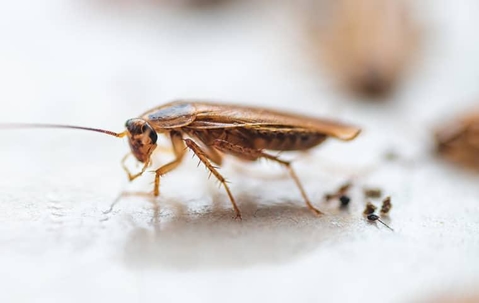Cockroaches are as tough as the legends say. They can live without their heads, survive pesticides, run three miles an hour, and have survived for over 100 million years. These prehistoric pests also carry a number of bacteria like E. Coli, Salmonella, and parasitic worms. They can worsen asthma, especially in children. Needless to say, it would take professional help and serious prevention efforts to keep them out of your home. There are three common cockroach species in the Long Island area to be aware of.
Three Common Cockroach Species In Long Island
Out of thirty cockroach species known to cohabitate with humans, three are common in Long Island. Each has unique tastes, habits, and threats.
American Cockroach
- Reddish-brown with a yellowish figure-eight behind the head
- Oval-shaped and winged
- Grow to be over two inches long
- Outdoors, live in sewers, pipes, flowerbeds, and under mulch piles
- Indoors, prefer kitchens, bathrooms, and basements
- Eat nearly anything, but prefer decaying material
The next species is smaller and has a few preference differences from its American cousin.
German Cockroach
- Light brown to tan with two dark stripes on its back
- Oval-shaped with wings it rarely uses
- Can grow to ⅝ of an inch long
- Prefer kitchens and bathrooms but will inhabit any place where food could be, including living rooms and bedrooms
- Eat anything with nutritional value, including soap and glue
- Can fit through holes as small as ⅜ of an inch
Finally, the third cockroach species is more likely to be found in closets and pantries.
Brown-Banded Cockroach
- Brown with x-shaped banding across the wings
- Oval-shaped bodies with wings that extend past the abdomen in males
- Females have stunted wings that prevent flight
- Grow to ½ an inch
- Found inside furniture, but prefer dry, warm locations like closets, and upper cabinets near ceilings
- Eat almost anything, including dyes, glues, and drapes
Combined, these species pose a real health threat to Long Island residents. Catching them early is the best bet to fully and quickly eliminate an infestation. These filthy pests leave plenty of signs to recognize.
How To Identify A Cockroach Infestation
While the easiest way to tell if you’ve got a cockroach problem is to see a cockroach itself, that’s not always guaranteed. Especially with nocturnal species like the brown-banded cockroach, you can’t rely on sightings alone. Instead, look for these warning signs of a cockroach infestation:
- Feces can vary in appearance from species to species. Some are small, pepper-like droppings. Some are rod-like and similar in appearance to mouse droppings.
- Fecal stains are often found around floors and door frames.
- Shed exoskeletons are another sign of cockroach infestation.
- As are egg sacks that may range from yellowish to reddish to dark brown.
- In large quantities, cockroaches may exude a “musty” odor.
Unfortunately, it’s not always possible to prevent a roach from coming indoors. They may hitchhike inside through groceries or used furniture. Structural protection and good sanitation will go a long way in preventing cockroaches, but the best way is with professional help from Parkway Pest Services.
Call Parkway Pest Services At The First Sign Of Roaches
Regular visits from a pest control professional offering pest control treatments for cockroaches are the most fool-proof way to keep your home pest-free. Parkway Pest Services can identify problems, prevent future ones, and eliminate harmful pests while keeping your safety and the environment in mind. We won’t just get rid of pests. We will protect your home from future risks by recommending prevention methods and structural changes that can keep you safe year-round. Call Parkway Pest Services for pest control in Long Island.

